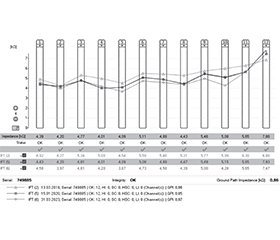Журнал «Здоровье ребенка» Том 19, №3, 2024
Вернуться к номеру
Віддалена динаміка імпедансу електродів кохлеарного імпланта у дітей
Авторы: Зайцев А.В. (1, 2), Березнюк В.В. (1), Березнюк І.В. (2), Чорнокур О.А. (1)
(1) - Дніпровський державний медичний університет, м. Дніпро, Україна
(2) - КП «Регіональний медичний центр родинного здоров’я» ДОР, м. Дніпро, Україна
Рубрики: Педиатрия/Неонатология
Разделы: Клинические исследования
Версия для печати
Актуальність. Сьогодні в Україні проживає близько 3 тис. користувачів кохлеарних імплантів, і їхня кількість постійно збільшується. Внутрішня частина імпланта знаходиться в завитці протягом всього життя пацієнта, але сучасні дані про стан електродів у віддаленому періоді мають суперечливий характер. Мета: оцінити динаміку імпедансу електродів кохлеарного імпланта протягом 5 років після операції у дітей. Матеріали та методи. Проведено ретроспективне дослідження 58 дітей з глухотою після кохлеарної імплантації. У дослідженні були вивчені та оцінені зміни міжелектродного імпедансу та взаємозв’язок між ними в різних частинах електрода через 1, 2, 3 та 5 років після початку електричної стимуляції. Результати. Через 1 рік після підключення мовного процесора було зафіксовано підвищення показників імпедансу в базальній частині електрода (9–12-й канали) відносно медіального та апікального відділів завитка. Протягом наступного року за даними телеметрії електричного поля була відзначена вірогідна (p < 0,05) тенденція до зниження опору в базальній частині імпланта (9–12-й електроди). У проміжку 2–5 років поступове зменшення показників імпедансу в медіальних та апікальних частинах електрода відбувалось без статистично значущих відмінностей. В 29,3 % випадків виявлена тенденція до поступового підвищення імпедансу на 11–12-му електродах протягом 3–5 років після операції. Ще у 8 пацієнтів (13,8 %) було виявлено критичне підвищення імпедансу (> 15 кОм) на одному з контактів у базальній частині електрода, що потребувало їх відключення або корекції налаштувань мовного процесора. Висновки. Рекомендується регулярний моніторинг імпедансу електродів та рівнів електростимуляції, особливо протягом перших 2 років використання імпланта. Це необхідно для підвищення продуктивності роботи імпланта, більш точного визначення максимально комфортних рівнів та порогів гучності, що дасть змогу поліпшити звукосприйняття у дітей після кохлеарної імплантації.
Background. Nowadays in Ukraine, there are about 3 thousand cochlear implant users, and their number is constantly increasing. The internal part of the implant remains in the cochlea throughout the patient’s life, but current data on the state of the electrodes in the long-term period are contradictory. The purpose was to study the impedance dynamics of cochlear implant electrodes during 5 years after surgery in children. Materials and methods. A retrospective study of 58 children with deafness after cochlear implantation was conducted. The changes in the interelectrode impedance and the relationship between them in the different parts of the electrode were evaluated and analyzed 1, 2, 3, and 5 years after the start of electrical stimulation. Results. At 1 year after the connection of the speech processor, an increase in the impedance was recorded in the basal part of the electrode (9–12 channels) relative to the medial and apical part of the cochlea. Over the next year, according to the electric field telemetry data, a significant (p < 0.05) downward trend was noted in the resistance in the basal part of the implant (9–12 electrodes). Within 2–5 years, a gradual decrease in the impedance in the medial and apical parts of the electrode occurred without statistically significant differences. In 29.3 % of cases, there was a tendency to a gradual increase in the impedance on 11–12 electrodes within 3–5 years after surgery. In another 8 patients (13.8 %), a critical increase in the impedance (> 15 kilohm) was detected on one of the contacts in the basal part of the electrode, which required their disconnection or correcting the settings of the speech processor. Conclusions. Regular monitoring of electrode impedance and electrical stimulation levels is recommended, especially during the first 2 years of implant use. This is necessary to improve the performance of the implant, to determine the most comfortable levels and thresholds of volume more accurately, which will improve the sound perception in children after cochlear implantation.
кохлеарний імплант; імпеданс електродів; телеметрія електричного поля
cochlear implant; electrode impedance; impedance and field telemetry

